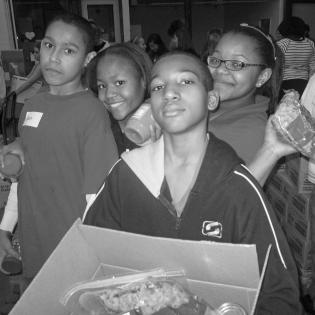It's Philanthropy
Young people learn about philanthropy through the book Uncle Willie and the Soup Kitchen and a visit from a nonprofit representative.
The learner will:
- define philanthropy and give examples of service that addresses the need of hunger.
- read-aloud copy of Uncle Willie and the Soup Kitchen by DyAnne DiSalvo-Ryan
Read about the service-learning project called Lunches of Love by elementary school students from Michigan. “I want my students to learn how to give back to their community. I realized that the children were not vested in school-initiated money or item collections. I want them to realize that they are part of the community and they can make a difference,” said elementary teacher Ms. Ferris.
Make arrangements in advance for a classroom visit from a volunteer or staff of your local soup kitchen or food pantry. Ask the guest to speak about the guests, the funding, how volunteers help, why people choose to volunteer, and what the kitchen does to preserve the dignity of the guests.
- DiSalvo-Ryan, DyAnne. Uncle Willie and the Soup Kitchen. New York: Harper Trophy, 1997. ISBN: 0688152856
Instructions
Anticipatory Set:
Ask young people to name some ways families help make their community better with their time and gifts, such as volunteering.
Write the following definition of philanthropy on the board: giving or sharing time, talent, or treasure and taking action for the common good.
Explain that sometimes people need help with the cost of healthy food for themselves or their families. A soup kitchen is a place in the community where people can go for a hot meal for free (or a small fee). Ask, "Do you think it would be a warm and inviting place or a sad place?" Tell them you are going to read a book about a soup kitchen and a person who works there. They can listen for Uncle Willie's attitude and the atmosphere of the soup kitchen.
Introduce and read the book Uncle Willie and the Soup Kitchen by DyAnne DiSalvo-Ryan. Explain that the soup kitchen is a nonprofit organization. The money to run a soup kitchen might come from donations and grants and the place might be run by volunteers.
After reading, ask young people to describe Uncle Willie and the atmosphere of the soup kitchen. Encourage them to talk about their feelings about the soup kitchen. Remind them of the definition of philanthropy, and discuss examples of philanthropy in the story.
Introduce the guest volunteer or staff of the local soup kitchen. They can tell the young people about their work and answer questions.
With the guest's assistance, brainstorm a list of needs for the soup kitchen. Discuss how the young people could be philanthropists by helping take action toward addressing these needs.
Thank the volunteer or staff of the soup kitchen for their visit. After the guest leaves, tell the young to write thank-you letters, including a sentence telling what they appreciated about the presentation.
Young people may make placemats to donate to the soup kitchen and brighten the day of the soup kitchen guests with friendly pictures and words. These may be laminated and donated to the soup kitchen. The artwork should be respectful and show sensitivity for the people who will use it.
Philanthropy Framework
-
Strand PHIL.I Definitions of Philanthropy
-
Standard DP 01. Define Philanthropy
-
Benchmark E.1 Define philanthropy as the giving and sharing of time, talent, or treasure intended for the common good.
-
-
Standard DP 02. Roles of Government, Business, and Philanthropy
-
Benchmark E.6 Explain why acting philanthropically is good for the community, state, nation, or world.
-
-
Standard DP 03. Names and Types of Organizations within the Civil Society Sector
-
Benchmark E.2 Name an example of a civil society charitable organization.
-
-
Standard DP 04. Operational Characteristics of Nonprofit Organizations
-
Benchmark E.1 Describe how citizens organize in response to a need.
-
-
-
Strand PHIL.II Philanthropy and Civil Society
-
Standard PCS 01. Self, citizenship, and society
-
Benchmark E.3 Describe a benefit of group cooperation.
-
-
Standard PCS 04. Philanthropy and Geography
-
Benchmark E.2 Identify and describe how civil society organizations help the community.
-
-
-
Strand PHIL.III Philanthropy and the Individual
-
Standard PI 01. Reasons for Individual Philanthropy
-
Benchmark E.1 Describe one reason why a person might give or volunteer.
-
Benchmark E.4 Give an example of how citizens act for the common good.
-
-
